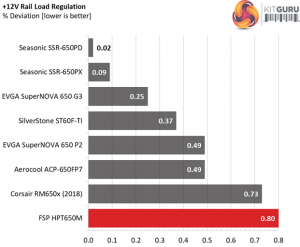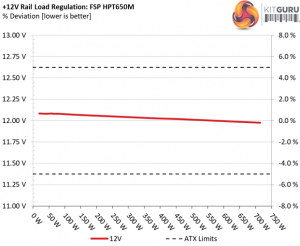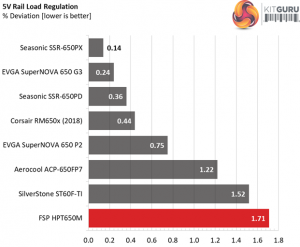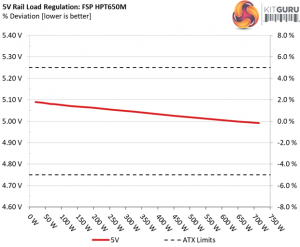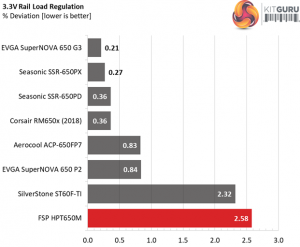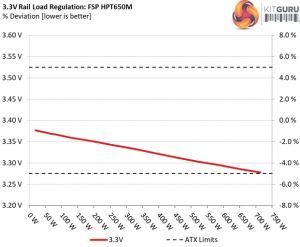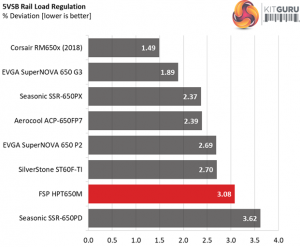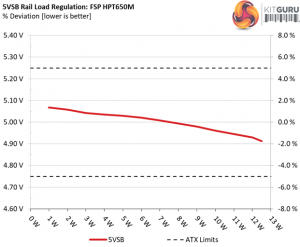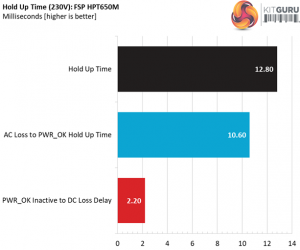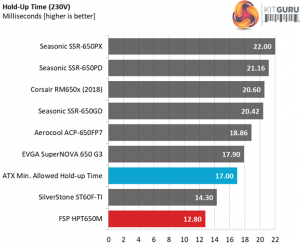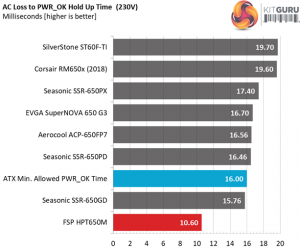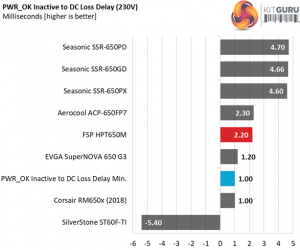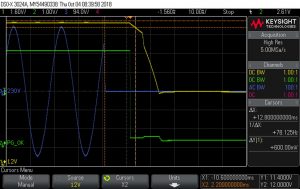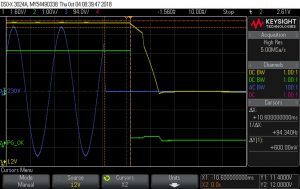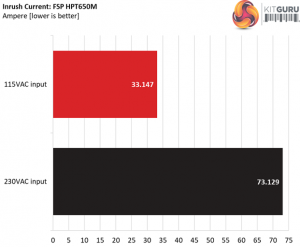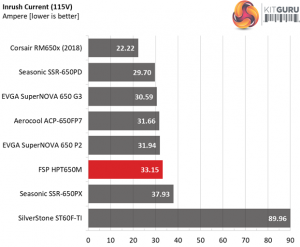To learn more about our PSU tests and methodology, please check out How We Test Power Supply Units.
Primary Rails And 5VSB Load Regulation
Load Regulation testing is detailed here.
Hold-Up Time
Our hold-up time tests are described in detail here.
The oscilloscope screenshots that we took during the hold-up time measurements:
The hold-up time is low, which is a great shame for a high-end 650W unit.
Inrush Current
For details on our inrush current testing, please click here.
The inrush current with 115V is at normal levels, however it is quite high with 230V.
Load Regulation And Efficiency Measurements
The first set of tests reveals the stability of the voltage rails and the HPT650M’s efficiency. The applied load equals (approximately) 10 to 110 percent of the power supplies maximum load in increments of 10 percentage points.
We conducted two additional tests.
During the first, we stressed the two minor rails (5V and 3.3V) with a high load, while the load at +12V was only 0.1A. This test reveals whether a power supply is compatible with Intel’s C6/C7 sleep states or not. In the second test, we determined the maximum load the +12V rail could handle with minimal load on the minor rails.
| Test # | 12V | 5V | 3.3V | 5VSB | DC/AC (Watts) | Efficiency | Fan Speed (RPM) | PSU Noise (dB[A]) | Temps (In/Out) | PF/AC Volts |
| 1 | 3.579A | 1.969A | 1.959A | 0.995A | 64.846 | 86.095% | 705 | 17.0 | 40.08°C | 0.845 |
| 12.081V | 5.081V | 3.369V | 5.029V | 75.319 | 42.90°C | 115.05V | ||||
| 2 | 8.157A | 2.958A | 2.947A | 1.195A | 129.346 | 90.007% | 708 | 17.1 | 40.63°C | 0.943 |
| 12.069V | 5.071V | 3.359V | 5.021V | 143.707 | 44.04°C | 115.05V | ||||
| 3 | 13.138A | 3.458A | 3.429A | 1.398A | 194.430 | 91.319% | 710 | 17.1 | 41.29°C | 0.970 |
| 12.059V | 5.063V | 3.351V | 5.008V | 212.912 | 45.21°C | 115.05V | ||||
| 4 | 18.131A | 3.958A | 3.948A | 1.603A | 259.663 | 91.644% | 703 | 17.0 | 41.82°C | 0.981 |
| 12.049V | 5.054V | 3.342V | 4.994V | 283.338 | 46.13°C | 115.05V | ||||
| 5 | 22.798A | 4.957A | 4.950A | 1.808A | 324.951 | 91.485% | 700 | 16.9 | 42.21°C | 0.986 |
| 12.038V | 5.045V | 3.333V | 4.979V | 355.195 | 47.14°C | 115.05V | ||||
| 6 | 27.409A | 5.959A | 5.959A | 2.016A | 389.482 | 91.091% | 697 | 16.9 | 42.81°C | 0.989 |
| 12.028V | 5.035V | 3.323V | 4.961V | 427.576 | 48.24°C | 115.05V | ||||
| 7 | 32.092A | 6.966A | 6.973A | 2.225A | 454.792 | 90.320% | 945 | 26.2 | 43.07°C | 0.990 |
| 12.018V | 5.025V | 3.313V | 4.946V | 503.532 | 48.80°C | 115.04V | ||||
| 8 | 36.785A | 7.977A | 7.994A | 2.435A | 520.098 | 89.657% | 1115 | 30.8 | 43.46°C | 0.991 |
| 12.007V | 5.016V | 3.303V | 4.930V | 580.099 | 49.54°C | 115.04V | ||||
| 9 | 41.880A | 8.491A | 8.497A | 2.438A | 584.991 | 88.985% | 1255 | 34.1 | 44.34°C | 0.991 |
| 11.998V | 5.007V | 3.295V | 4.923V | 657.406 | 50.91°C | 115.04V | ||||
| 10 | 46.920A | 9.004A | 9.037A | 2.546A | 649.690 | 88.243% | 1425 | 35.0 | 45.54°C | 0.991 |
| 11.988V | 4.999V | 3.286V | 4.912V | 736.247 | 52.40°C | 115.04V | ||||
| 11 | 52.381A | 9.019A | 9.062A | 2.550A | 714.536 | 87.343% | 1617 | 40.6 | 46.62°C | 0.991 |
| 11.976V | 4.991V | 3.278V | 4.903V | 818.077 | 53.82°C | 115.03V | ||||
| CL1 | 0.138A | 14.002A | 13.999A | 0.000A | 119.144 | 86.459% | 715 | 17.2 | 42.21°C | 0.942 |
| 12.052V | 5.049V | 3.342V | 5.042V | 137.804 | 47.18°C | 115.05V | ||||
| CL2 | 54.171A | 1.002A | 1.000A | 1.000A | 663.351 | 88.522% | 1380 | 37.0 | 45.86°C | 0.991 |
| 12.000V | 5.016V | 3.301V | 4.971V | 749.365 | 52.72°C | 115.03V |
The load regulation at +12V is satisfactory and the 5V rail stays within 2%. The regulation at 3.3V could be much better though, since the competition is way ahead here. This rail might not be so important nowadays, but from the moment it is included in the ATX spec and some components still use it, it should have the best possible performance.
The fan profile is super relaxed. It takes more than full load to force the fan spin at 1617 RPM, where the noise output slightly exceeds 40 dB(A). This means that under normal operating temperatures you will barely hear the PSU's fan.
With 20% load the corresponding 80 PLUS Platinum requirement is met, however this is not the case with 50% and 100% loads. Nevertheless, we test at a much higher ambient so it is normal to get lower efficiency readings.
 KitGuru KitGuru.net – Tech News | Hardware News | Hardware Reviews | IOS | Mobile | Gaming | Graphics Cards
KitGuru KitGuru.net – Tech News | Hardware News | Hardware Reviews | IOS | Mobile | Gaming | Graphics Cards


